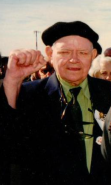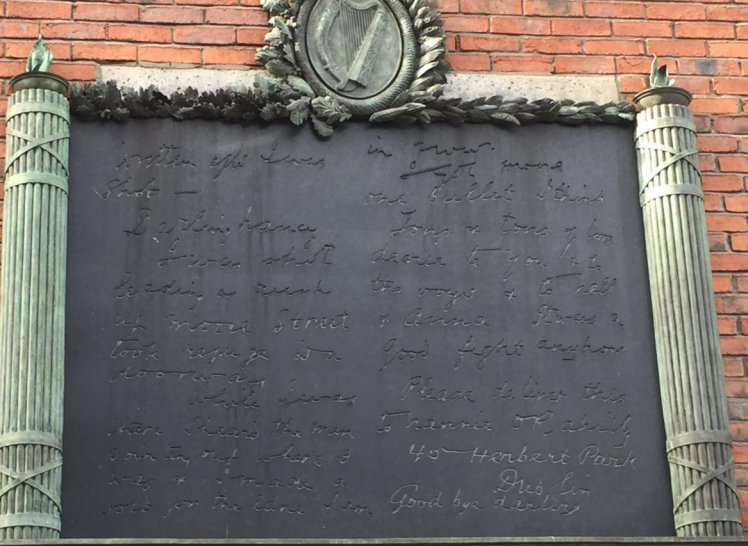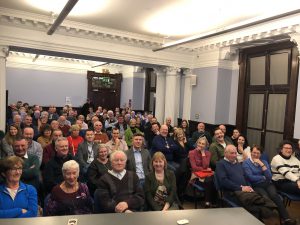On the 16th of October, 2016, I had the pleasure of bringing a large group of people from the International Brigade Memorial Trust on a tour of Dublin. The Trust is made up of relatives and friends of those who fought the good fight in Spain against Franco. The tour was organised by Manus O’Riordan and we focused on the role of the Irish Citizen Army in 1916.
Manus is the son of Michael O’Riordan (1917-2006) who fought in Spain as part of the XV (Fif teenth) International Brigade. Michael, a member of the IRA, went to Spain with Frank Ryan in 1937 as part of the Connolly Column. Michael was wounded in action on the Ebro Front. Michael was also a founder of the Communist Party of Ireland and a shop he founded, Connolly Books, can be found on Essex Street in Temple Bar and is well worth a visit.
teenth) International Brigade. Michael, a member of the IRA, went to Spain with Frank Ryan in 1937 as part of the Connolly Column. Michael was wounded in action on the Ebro Front. Michael was also a founder of the Communist Party of Ireland and a shop he founded, Connolly Books, can be found on Essex Street in Temple Bar and is well worth a visit.
Amongst the participants of today’s tour were people from England, Scotland, Wales, the US and indeed one or two from Spain including Manuel who correctly admonished me for harassing a wasp (Ireland’s only natural predator) who was bugging us! We started the tour at the entrance into Stephen’s Green (Traitor’s Gate) and chatted about how the Irish Citizen Army under Michael Mallin and Countess Markievicz occupied the park during the Easter Rising. We visited the rock of granite dedicated to O’Donovan Rossa and then paid our respects to Bold Robert Emmet who led an Uprising against British rule in 1803 with no more than 80 United Irishmen. We then examined the bullet holes in the College of Surgeons and mused over why they still refer to themselves as the Royal College of Surgeons in Ireland, despite the fact that we have little to do with Monarchy. I always love the phrase…”Monarchy, best before date: 1789. Anything after that is a little stale.”
We also went to Dublin Castle and of course City Hall which was occupied in ’16 by Sean Connolly and Sean O’Reilly, both of whom were shot during the Rising. Dr Kathleen Lynn of the ICA surrendered the City Hall Garrison after two days of fierce fighting on the doorstep of Dublin Castle.
Down at the General Post Office we discussed the tactics used by the revolutionaries in 1916 and spoke about the events of Easter Week in that iconic building. I explained how Michael Joseph O’Rahilly led a final charge down Moore Street and how he was shot to bits but wrote that wonderful final note to his wife to let her know that “it was a good fight anyhow”.
Manus was keen that we show our guests Moore Street and explain the ongoing battle to save it from the wrecking ball of a certain developer. Of course it is sad that 2016 will pass with no museum and with our own government determined to appeal the High Court ruling that Moore Street should be preserved. However 2016 is just a year and 1916 will be equally important next year and for many years after so there is still time to implement the will of the people of Ireland and that is to see the terrace of houses, occupied by Patrick Pearse, James Connolly, Joseph Plunkett, Sean MacDiarmada and Tom Clarke, preserved for future generations.
It was fantastic to spend a few hours with the sons and daughters of the men who fought for a Spanish Republic in the XV International Brigade. Try and get your hands on Michael O’Riordan’s inspirational book Connolly Column: The Story of the Irishmen who fought for the Spanish Republic, 1936–1939.


 It was a great pleasure to be asked to speak in the National Library of Ireland on Tuesday 21 January 2020. This was the first lecture in a series of planned events that the NLI have for 2020 and the topic was the IRA’s Guerrilla Campaign 1919-21. Seven o’clock on a Tuesday, you wouldn’t expect many people to turn up but we had a full house of enthusiastic history lovers.
It was a great pleasure to be asked to speak in the National Library of Ireland on Tuesday 21 January 2020. This was the first lecture in a series of planned events that the NLI have for 2020 and the topic was the IRA’s Guerrilla Campaign 1919-21. Seven o’clock on a Tuesday, you wouldn’t expect many people to turn up but we had a full house of enthusiastic history lovers. teenth) International Brigade. Michael, a member of the IRA, went to Spain with Frank Ryan in 1937 as part of the Connolly Column. Michael was wounded in action on the Ebro Front. Michael was also a founder of the Communist Party of Ireland and a shop he founded,
teenth) International Brigade. Michael, a member of the IRA, went to Spain with Frank Ryan in 1937 as part of the Connolly Column. Michael was wounded in action on the Ebro Front. Michael was also a founder of the Communist Party of Ireland and a shop he founded, 